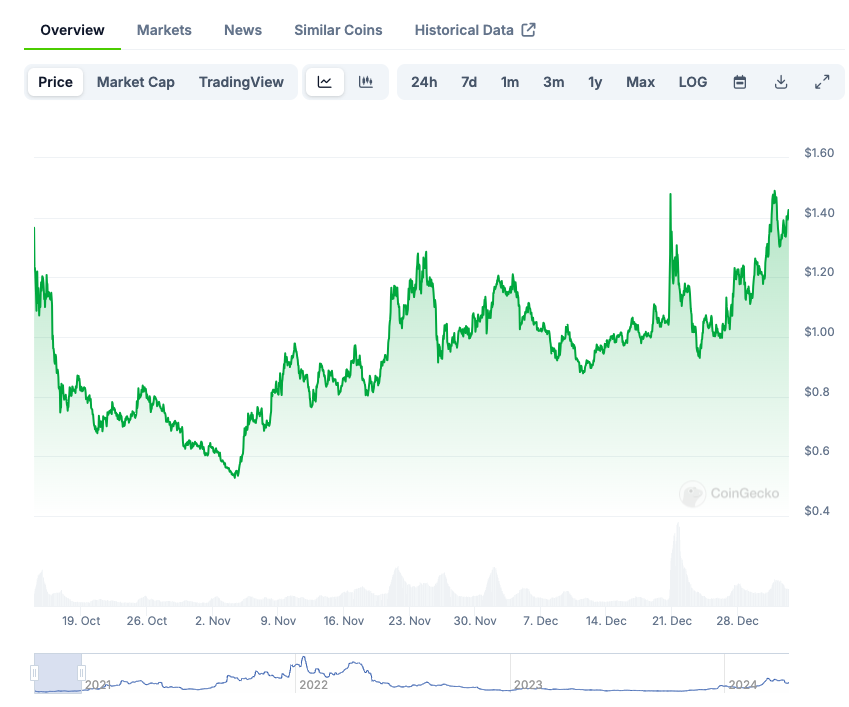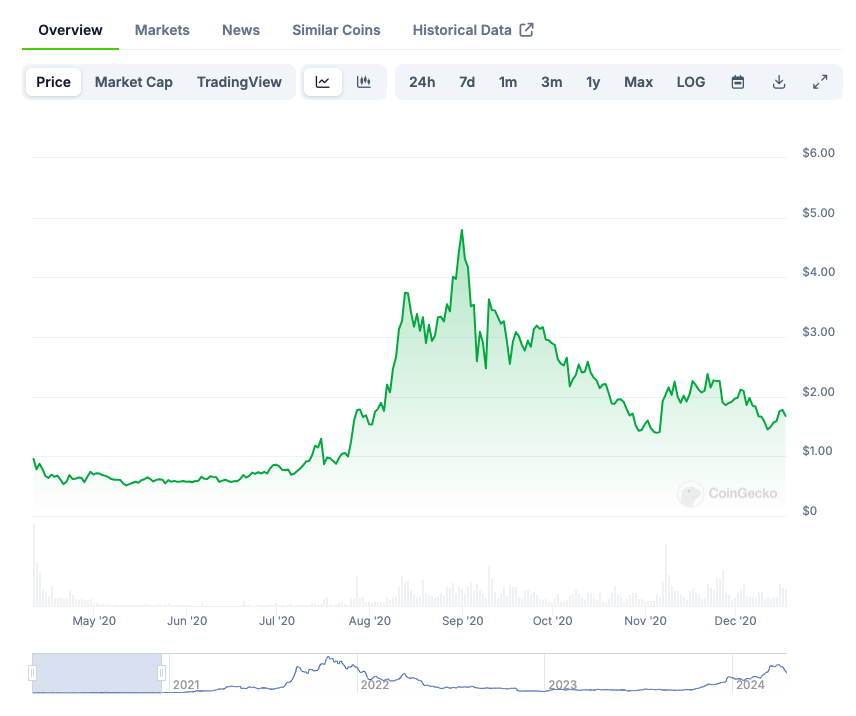Original author: Regan Bozman
Original translation: TechFlow
The current token issuance structure encourages a "down-and-out" model in which the price of tokens will be slammed.
Tokens are issued at a high FDV, slowly drain away as airdrop recipients sell, then collapse as VC unlocks.
Some ideas on how to break the current pattern
Mike Zajko always describes the worst-case scenario for a team’s token trajectory as an ICP chart, and if your token price looks like this, you’re in trouble in the long run.
Reflexivity can be a wonderful thing for a protocol, and price appreciation can help catalyze a real community/developer ecosystem
But the reverse is also true, and can be very cruel.
Before I go any further, let’s quickly define a few things. There are two main metrics for token supply:
Circulating Supply: Tokens in circulation
Fully Diluted Supply: Maximum number of tokens
The circulating supply will increase over time until it equals the fully diluted supply
For example, if team tokens are locked up at the TGE (Token Generation Event), they are added to the circulating supply when they start to vest in month 12. They are always part of the fully diluted supply.
Market capitalization = circulating token supply * price, fully diluted valuation (FDV) = fully diluted supply * price.
Market capitalization is a measure of demand, while FDV is simply a measure of supply.
Market capitalization is the total value of public demand, it rises and falls with price changes and is a reliable indicator assuming good liquidity.
FDV increases with market capitalization because both metrics are based on current market token prices, however, rising market capitalization does not imply additional demand for these locked tokens.
Holders of locked tokens may actually be happy to sell at a much lower price, so FDV may not be a very accurate measure of true network value.
There is an argument that FDV (fully diluted valuation) is actually a meme because some tokens are trading at crazy FDVs (e.g. Worldcoin has a FDV of $50 billion)
This may make sense for retail investors because if you trade frequently in these assets, the FDV may not be that important unless you are stuck at the unlock.
But FDV is absolutely important to VCs because they are the ones holding the locked tokens ! Currently, the vast majority of funding agreements from VCs have a one-year lockup period and then expire in the next 18-36 months.
VCs are supposed to value assets at their expected FDV in 3-4 years because that’s a true reflection of what they can return to LPs, but alas that’s not how this market works.
So what is this current paradigm that I’m talking about?
Issue tokens at high FDV (fully diluted valuation)
<20% of token supply in circulation
No public token sales
Massive Airdrop
Dymension is an example, launching with $8 billion in FDV, 16% of circulating supply, no public sales, and a nine-figure airdrop.

Why does this happen?
I think once the airdrop paradigm started, this became a way to increase the dollar value of the airdrop without adding more tokens.
And it boosts the ego of the team and the venture capitalists.
Yes, VCs and teams can sell locked tokens, but I’m not sure how much demand there is for locked tokens, so not sure how common this is.
But the above is not always the way these projects are launched! Most of the leading L1 (first layer blockchain) today
At the time of issuance, the FDV was less than $1 billion
The unlocking method is generally similar, but the vesting period is usually shorter
Retail investors can buy at relatively low prices (<$500 million FDV)
No airdrops
Taking NEAR as an example, the circulation volume was 20% at launch, but community sales began to unlock it immediately, 50% was in circulation within 1 year, and the FDV at launch was 500-800 million US dollars.

SOL started with about 20% in circulation, but after a year about 75% was in circulation. The initial FDV was between $300 million and $500 million.
You could buy $SOL for less than $5 for many, many months.

$LINK was issued at a FDV of hundreds of millions, and in the first 18 months of trading, the FDV was typically below $1 billion.
These tokens all have strong communities and a solid base of token holders, and their costs are relatively low. What are these legendary crypto communities we always talk about?
IMHO: Community means making money with your fellow netizens. In the cryptocurrency space, there are few strong communities that don’t make money.
Looking back at the ICP graph, do you really think there is a strong ICP community? Not at all.
What happens next?
The price of a token will only increase if there are more buyers than sellers.
So who are the buyers in today's market? Definitely not institutional investors!
Yes, there are some liquidity funds, and there are some crypto VC funds buying tokens, but there really isn’t a lot of capital flowing into the liquid market.
If we leave ETH/BTC aside, its absolute maximum annual inflow is only US$10 billion to US$15 billion.
This week alone we saw the launch of three tokens with a combined supply of over $5 billion, with no chance of enough institutional bids to eat up the supply on the market.
Ultimately, the end buyers of all of these tokens are retail investors.
But the problem is that retail investors have very limited interest in high-valuation, low-circulation tokens. There are two problems:
First, these tokens are expensive. No one would think it is worthwhile to buy something with a ten-digit FDV.
Second, with these large airdrops, retail investors are getting tokens for free! So why would they buy more?
The most anticipated token launch of the year
EigenLayer will likely be issued at a price of 10 billion+ FDV. I bet that at least most ETH holders with a certain level of knowledge are already farming Eigenlayer
Over 3% of all ETH has been deposited and a $5 billion+ ecosystem has formed around the airdrop narrative.
Thinking logically, if you want the Eigenlayer airdrop, you most likely already own ETH.
If you have ETH, you are probably using it to earn Eigen tokens right now! So a large portion of potential buyers will get tokens for free.
Of course people can go buy more and there will obviously be some non-zero buying, but I'm skeptical it's a huge market
I personally have a fair bit of ETH in various LRTs or Eigen, hoping to get a decent airdrop.
If it was $20 billion FDV, would I buy more? The answer is obviously no.
So what is the other buyers market?
Retail investors want exposure to Eigenlayer but are unable to purchase tokens for a variety of reasons. Obviously, the pool of buyers is not zero, but I don't believe there is a large number of retail investors who want to buy $EIGEN at $25 billion in FDV.
Well, we’ve already established that the buy-side audience is limited.
What about the seller?
If your FDV is high enough, VCs will obviously sell!
If you’ve gone from a $100M seed round to a $20B FDV, it makes perfect sense to take money off the table!
Retail investors are aware of this dynamic and are tracking it! The token unlock is well documented, click here to learn more .
Are airdrop participants selling? I haven’t seen a lot of data on what percentage of this round of airdrops sold, but there’s a clear psychological concept that you value something you get for free less than something you buy.
Most airdrops are also based on the nominal value of the assets you deposit/collateralize, so they don’t represent a large percentage of your portfolio, for example, if you deposit 1 eth in Eigen you might get points worth 0.05-0.01 eth, so it doesn’t mean much to most people who take advantage of airdrops.
So that's why we're in a downwards only paradigm, and I'm not trying to pick on these projects. I don't know what they're doing, I think they're well-intentioned, and Eigen is a novel product.
How to break out of this pattern?
I think there are three ways to get out of this current situation:
Linear unlocking
Public Token Sale
Create cool stuff
6MV has done some great research and generally found that smaller unlock events have less of an impact on price than larger events.
I think the right direction should be to have 20-25% of tokens in circulation at the time of TGE, with a linear unlocking method over 36 months.
Also, you should adopt a public token sale. Get retail investors to buy into your project on a large scale. Near’s token sale had such high demand that it crashed the CoinList website twice.
Clearly there is huge demand before the TGE! Allowing the community to accumulate $5-25K in tokens outside of the airdrop will buy more loyalty.
Finally, it’s about creating cool stuff. The projects that do well in this cycle tend to be super novel, like Ethena or Jito. Not sure if this holds true for the rest of the cycle, but intuitively it probably does.
Perhaps retail investors are tired of being pushed the tenth parallel DA (data availability) modular solution.
Venture capitalists can complain about meme coins causing them trouble, but if they think the market structure of previous cycles will last forever, then the problem is actually them.
I remain highly bullish and we are actively deploying. This is not a macro view of the market.
This is a warning that buying into the current token offering structure is clearly not going to set you up for long term success.
I have been bringing these protocols to market for the past decade and have witnessed dozens of times what works and what doesn’t.
Stop listening to bad advice from VCs, consultants, or anyone else who tries to tell you that it’s smart to buy at the highest FDV.



